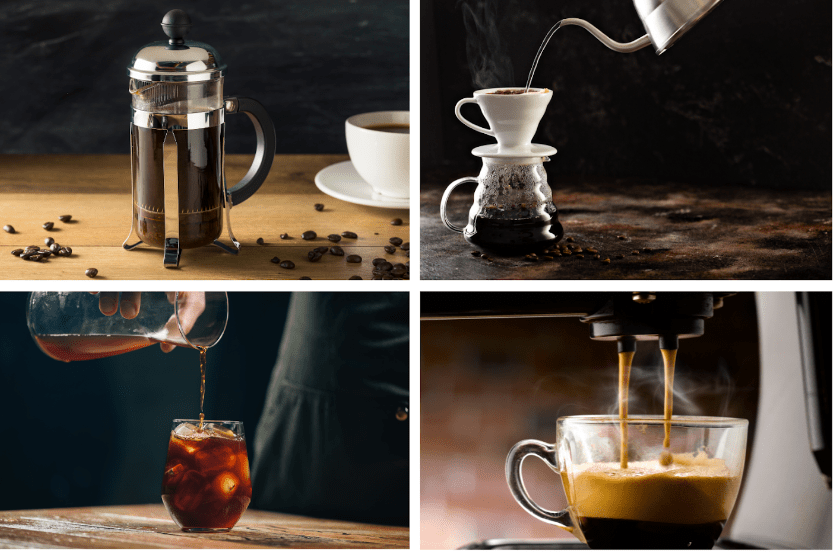Can I manipulate the caffeine levels in my coffee?
Another one? If the bartender of your choice asks that question they are in charge of the buzz you get.
When it comes to coffee, you have more control than you might be aware of. Did you know that the way you brew at home can influence your java’s caffeine content? Whether you're looking to maximize your intake or dial it down, understanding the brewing process can help you tailor your cup to your needs.

The Role of Bean Variety and Roast
Before we get into brewing techniques, it's important to note that the type of bean you choose plays a role in caffeine content. Most coffees on the market are Arabica varieties, which generally have less caffeine than Canephora (Robusta) beans, but are more tasty. However, in recent years, Robusta has been on the rise, due to Arabica’s problems of coping with climate change and rising prices. Many commercial blends have always contained both Arabica and Robusta, and we will see more fine Robusta varieties hit the market in coming years.
As far as roasts go, lighter roasts tend to retain slightly more caffeine than darker ones due to the roasting process, which can burn off some of the caffeine molecules, as they dissolve at 180 degrees celsius.
Here is what you control

- Grind Size
The grind size you choose is a factor in caffeine extraction:
- Coarse Grind: A coarser grind results in faster extraction and less caffeine content in any brewing method that uses gravitation, because of a shorter brew time. However, in immersion methods (see below) a long steep time and manual movement gives caffeine a higher chance to extract.
- Medium Grind: Suitable for drip coffee makers and pour-over methods. This grind strikes a balance, offering moderate caffeine levels.
- Fine Grind: Best for espresso and AeroPress. Finer grounds increase the surface area of coffee particles that is available for extraction, leading to higher caffeine content in a shorter brewing time.

- Brewing Methods
Different brewing methods not only affect the flavor but also the caffeine content:
- Espresso: Despite its small serving size, espresso packs a punch with high caffeine concentration due to the fine grind and short extraction time. A shot of espresso (about 1 ounce) contains roughly 63 mg of caffeine.
- Drip Coffee and pour overs: Drip coffee makers and most pour over methods (e.g. V60, Kalita, Tornado) use a medium grind and medium brewing time, resulting in about 95 mg of caffeine per 8-ounce cup. Note: A regular 12-ounce cup of drip has relatively more caffeine than a double shot of espresso, 120mg vs 80mg, even though the espresso tastes way stronger of course.
- French Press: This method uses a coarse grind and longer steeping time, typically yielding around 80-100 mg of caffeine per 8-ounce serving.
- Cold Brew: Known for its smooth taste, cold brew uses a coarse grind and extended brewing time (up to 24 hours), resulting in a highly caffeinated beverage, often around 200 mg per 8-ounce cup.
Generally: Immersion methods (French Press and Cold Brew) give you the most control over your caffeine levels because you can control time and movement.
- Water Temperature and Brew Time
- Water Temperature: Brewing temperature ranges between 195°F and 205°F (90°C to 96°C). Hotter water extracts caffeine more efficiently. However, boiling water (212°F or 100°C) can over-extract, leading to a bitter taste.
- Brew Time: Longer brewing times generally increase caffeine extraction. For instance, cold brew’s extended steeping period results in higher caffeine content compared to a quick espresso shot.
- Coffee-to-Water Ratio
The ratio of coffee grounds to water also impacts caffeine levels:
- Strong Brew: A lower coffee-to-water ratio (e.g., 1:15) means relatively more caffeine.
- Milder Brew: A higher ratio (e.g., 1:18 or 1:20) results in relatively less caffeine.
Conclusion
Understanding how grind size, brewing method, water temperature, brew time, and coffee-to-water ratio work together allows you to manipulate the caffeine content of your home-brew up to a point.
Just keep in mind that every single element you change impacts all others. The best way to experiment is to start with your favorite recipe, tweak one thing at a time and let your tastebuds decide.
An extraction rate of 22% of the bean is ideal. Less leads to sour und underextracted taste, more leads to bitterness.
So your taste and tolerance limit the caffeine content naturally, but you can absolutely create your own energy shot if you combine some of the variables above.
Happy brewing!

